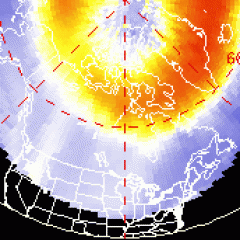Space Weather Update~ Chance for M Class Flares [1]
TOTAL ECLIPSE OF THE SUN: Scientists and sky watchers are converging on the northeast coast of Australia, near the Great Barrier Reef, for a total eclipse of the sun on Nov. 13/14. For researchers, the brief minutes of totality open a window into some of the deepest mysteries of solar physics. [video [2]] [full story [3]]
FARSIDE EXPLOSION: As solar activity picks up on the Earthside of the sun (see "Broken Quiet" below), the farside of the sun is coming alive, too. During the early hours of Nov. 9th, a magnetic filament located behind the sun's southeastern limb erupted, hurling a bright coronal mass ejection (CME) into space:
This explosion was not geoeffective, but future explosions might be. The blast site, still potent, is just days away from rotating onto the Earthside of the sun. You can monitor its progress using NASA's 3D Sun app [5] for smartphones, which makes it easy to view and explore the farside of the sun.
BROKEN QUIET: A weeks-long spell of solar quiet was broken on Nov. 8th (02:34 UT), when new sunspot AR1611 unleashed an M1.7-class flare. NASA's Solar Dynamics Observatory captured the extreme UV flash:
Because of the blast site's location on the sun's northeastern limb, Earth was not in the line of fire. It will take about a week for this new active region to turn squarely toward our planet. Stay tuned for updates as the chance of geoeffective flares increases in the days ahead. Solar flare alerts: text [7], voice [8].

![]()
Solar wind
speed: 290.8 km/sec
density: 1.4 protons/cm3
explanation [9] | more data [10]
Updated: Today at 1556 UT
![]()
X-ray Solar Flares
6-hr max: C1 1103 UT Nov10
24-hr: C2 0504 UT Nov10
explanation [11] | more data [12]
Updated: Today at: 1600 UT
![]()
![]()
![]()
Daily Sun: 09 Nov 12
![]()
![]()
New sunspot 1611 poses a threat for M-class [14] solar flares. Credit: SDO/HMI
![]()
![]()
![]()
Sunspot number: 65
What is the sunspot number? [15]
Updated 09 Nov 2012
Spotless Days
Current Stretch: 0 days
2012 total: 0 days (0%)
2011 total: 2 days (<1%)
2010 total: 51 days (14%)
2009 total: 260 days (71%)
Since 2004: 821 days
Typical Solar Min: 486 days
Update 09 Nov 2012
The Radio Sun
10.7 cm flux: 104 sfu
explanation [16] | more data [17]
Updated 09 Nov 2012
![]()
![]()
![]()
Current Auroral Oval:
![]()
Switch to: Europe, USA, New Zealand, Antarctica
Credit: NOAA/POES
![]()
![]()
![]()
Planetary K-index
Now: Kp= 1 quiet
24-hr max: Kp= 1 quiet
explanation [19] | more data [20]
![]()
Interplanetary Mag. Field
Btotal: 3.1 nT
Bz: 0.5 nT north
explanation [21] | more data [22]
Updated: Today at 1556 UT
![]()
![]()
![]()
Coronal Holes: 09 Nov 12
![]()
![]()
There are no large coronal holes on the Earthside of the sun. Credit: SDO/AIA




